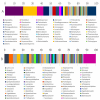Once upon a Time, There Was a Piece of Wood: Present Knowledge and Future Perspectives in Fungal Deterioration of Wooden Cultural Heritage in Terrestrial Ecosystems and Diagnostic Tools
- PMID: 38786721
- PMCID: PMC11122135
- DOI: 10.3390/jof10050366
Once upon a Time, There Was a Piece of Wood: Present Knowledge and Future Perspectives in Fungal Deterioration of Wooden Cultural Heritage in Terrestrial Ecosystems and Diagnostic Tools
Abstract
Wooden Cultural Heritage (WCH) represents a significant portion of the world's historical and artistic heritage, consisting of immovable and movable artefacts. Despite the expertise developed since ancient times to enhance its durability, wooden artefacts are inevitably prone to degradation. Fungi play a pivotal role in the deterioration of WCH in terrestrial ecosystems, accelerating its decay and leading to alterations in color and strength. Reviewing the literature of the last 25 years, we aimed to provide a comprehensive overview of fungal diversity affecting WCH, the biochemical processes involved in wood decay, and the diagnostic tools available for fungal identification and damage evaluation. Climatic conditions influence the occurrence of fungal species in threatened WCH, characterized by a prevalence of wood-rot fungi (e.g., Serpula lacrymans, Coniophora puteana) in architectural heritage in temperate and continental climates and Ascomycota in indoor and harsh environments. More efforts are needed to address the knowledge fragmentation concerning biodiversity, the biology of the fungi involved, and succession in the degradative process, which is frequently centered solely on the main actors. Multidisciplinary collaboration among engineers, restorers, and life sciences scientists is vital for tackling the challenges posed by climate change with increased awareness. Traditional microbiology and culture collections are fundamental in laying solid foundations for a more comprehensive interpretation of big data.
Keywords: Aspergillus niger; Coniophora puteana; FTIR; Serpula lacrymans; architectural wood biodeterioration; cellulase activity; extremotolerant fungi; lignin degradation; metabolic plate assays; wood-decaying fungi.
Conflict of interest statement
The authors declare no conflicts of interest.
Figures











Similar articles
-
Biological-degradation, lignin performance and physical-chemical characteristics of historical wood in an ancient tomb.Fungal Biol. 2025 Jun;129(4):101588. doi: 10.1016/j.funbio.2025.101588. Epub 2025 Apr 22. Fungal Biol. 2025. PMID: 40441799
-
Improved molecular methods to characterise Serpula lacrymans and other Basidiomycetes involved in wood decay.J Microbiol Methods. 2011 Feb;84(2):208-15. doi: 10.1016/j.mimet.2010.11.018. Epub 2010 Dec 10. J Microbiol Methods. 2011. PMID: 21146565
-
Deception Island, Antarctica, harbors a diverse assemblage of wood decay fungi.Fungal Biol. 2017 Feb;121(2):145-157. doi: 10.1016/j.funbio.2016.11.009. Epub 2016 Dec 8. Fungal Biol. 2017. PMID: 28089046
-
Wood-water relationships and their role for wood susceptibility to fungal decay.Appl Microbiol Biotechnol. 2020 May;104(9):3781-3795. doi: 10.1007/s00253-020-10479-1. Epub 2020 Mar 6. Appl Microbiol Biotechnol. 2020. PMID: 32144473 Free PMC article. Review.
-
Fungal biodeterioration and preservation of cultural heritage, artwork, and historical artifacts: extremophily and adaptation.Microbiol Mol Biol Rev. 2024 Mar 27;88(1):e0020022. doi: 10.1128/mmbr.00200-22. Epub 2024 Jan 5. Microbiol Mol Biol Rev. 2024. PMID: 38179930 Free PMC article. Review.
Cited by
-
Diversity and Ecology of Fungi from Underexplored and Extreme Environments.J Fungi (Basel). 2025 Apr 28;11(5):343. doi: 10.3390/jof11050343. J Fungi (Basel). 2025. PMID: 40422677 Free PMC article.
References
-
- Rowell R.M. Handbook of Wood Chemistry and Wood Composites. CRC press; Boca Raton, FL, USA: 2005. - DOI
-
- Lo Monaco A., Balletti F., Pelosi C. Wood in cultural Heritage. Properties and conservation of historical wooden artefacts. Eur. J. Sci. Theol. 2018;14:161–171.
-
- Pettersen R.C. The chemical composition of wood. In: Rowell R., editor. The Chemistry of Solid Wood 1984. Volume 207. American Chemical Society; Washington, DC, USA: 1984. pp. 57–126.
-
- Meiggs R. Trees and Timber in the Ancient Mediterranean World. Oxford University Press; London, UK: 1982. p. 553.
-
- Blanchette R.A. A review of microbial deterioration found in archaeological wood from different environments. Int. Biodeterior. Biodegrad. 2000;46:189–204. doi: 10.1016/S0964-8305(00)00077-9. - DOI
Publication types
Grants and funding
LinkOut - more resources
Full Text Sources

